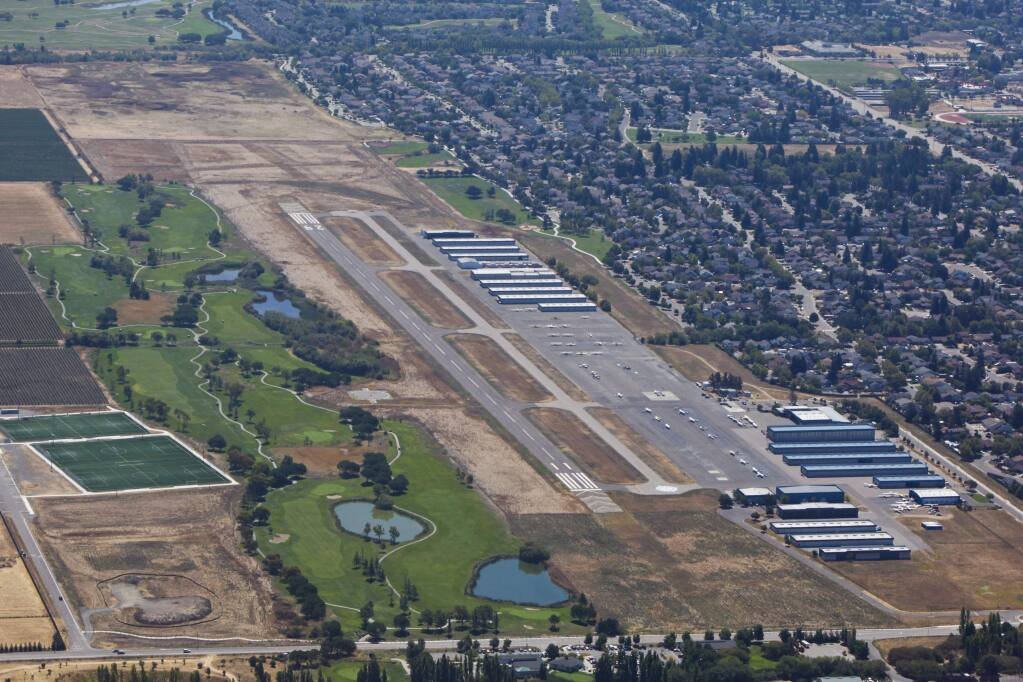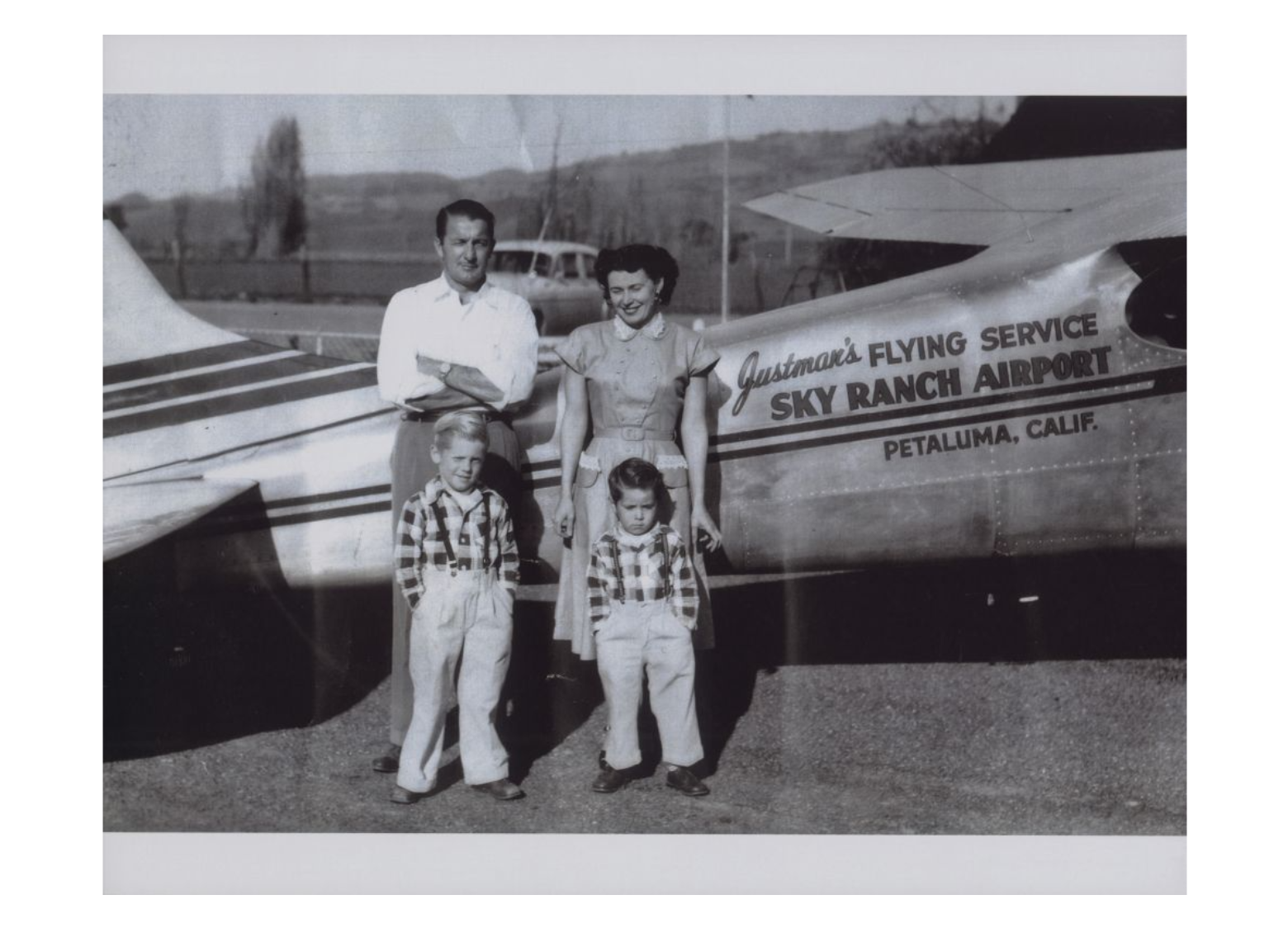
About The Airport

Airport History
According to this list of Civil Airports of California, Petaluma’s first airport was founded in 1915 by Lawrence Pingpank. Located somewhere southwest of Ely Road, from 1924 to 1926 it was home to the Pingpank-Buck Flying School. This aerial photo dated 1923 shows the site:
In the mid-1940s, George Justman and his wife Violet built Petaluma Sky Ranch Airport, home to Justman’s Flying Service. The couple received FAA approval as a flight school in 1948, and originally operated with a gravel runway 1800 feet long by 30 feet wide. Justman’s Petaluma Sky Ranch Airport began operating in May of 1949. The grand opening was on July 10, 1949 with an air show including a military flyover. There was but one hangar, a fuel island, and a residence that doubled as an office. The Justmans lived on and operated the field until 1962, with their sons Robert and William. Their original airport is now known as the Petaluma Municipal Airport located on 601 Sky Ranch Drive.
Standing by airplane: rear left to right: George Justman (November 7, 1914-January 7, 2005), Violet Patocchi Justman (July 12, 1924- October 20, 2021); front left to right: Robert A. Justman (December 28, 1947- ); William C. Justman (February 3, 1950- ).
Today’s Airport
In early 1984, the City of Petaluma received a Federal Aviation Administration grant for the development of a new airport. As a first step, the City acquired the 22 acres encompassing the old Sky Ranch Airport plus an additional 197 adjacent acres. Construction began in the fall of 1984. A new paved runway was built somewhat farther east, 3600 feet long by 75 feet wide. A partial ramp and lighting system were also built. The new City airport was dedicated at the annual Air Fair on September 1, 1985.
Subsequent grants and additional funding have extended the ramp and provided a new fuel system, access road, sewer and water system, lighting and hangars. Today’s airport has a total investment of about 14 million dollars. These funds have come from Federal Aviation Administration grants, State loans, enterprise fund financing and private developer contributions. While City-owned, the airport is self-supporting through airport receipts such as tie down and hangar fees, business leases and fuel revenues.
There were about 60 airplanes based at the old Sky Ranch Airport. The City airport currently has about 240 aircraft in 160 city-owned hangars and 62 tie-downs. Planned airport capacity is 368 aircraft.
Flying to Petaluma Airport (KO69)
AOPA Online has a great article on flying to Petaluma. In addition to local activities, it mentions our seasonal morning and afternoon fog and the prevailing winds, which typically favor runway 29. Note that runway 29 has right traffic, with the downwind leg flown outside (northeast) of Old Adobe Road. Light Sport aircraft often fly at 700′ MSL or below and closer in; they may or may not have radios, so be watchful.
SkyVector aeronautical charts and the map above show how the airport is situated along the northeast edge of the city, adjacent to Sonoma Mountain.
Facts and Figures
The Airnav.com, AOPA and SkyVector.com O69 pages have all the facts & figures about the Petaluma airport.
Weather
For weather, see the METAR at right from O69’s AWOS, for the Santa Rosa airport (STS) to the northwest, Novato (DVO) to the south and Napa (APC) to the east. While these are no substitute for an official weather briefing from an approved source, they’ll give you an idea of local conditions.
Fuel
Chevron 100LL aviation fuel is available 24 hours a day from self-serve pumps located in front of the airport office, near the transient parking area. Jet fuel service is available by truck during regular hours, and after hours for a call-out fee of $25.00. For prices and more information, see the City’s airport page.
Ground Communications Outlet
Petaluma Airport has a “Ground-Link” Ground Communications Outlet to Oakland Center or FSS Wx Brief. This is a radio-to-telephone link available within the airport area on 121.72 MHz. While on the ground, you can contact FSS for a weather briefing or Oakland Center to obtain or cancel an IFR Flight Plan.
To contact Oakland Center, key the mic and say “Air – Traffic – Control” or click the mic four (4) times.
To contact FSS Wx Brief, key the mic and say “Call – Flight – Service – Station” or click the mic six (6) times.
The system will ask you to click the mic twice if it is dialing the correct location. If it is not correct, wait for (5) seconds and then start again.
The GCO will then dial the appropriate phone number. You will hear it dialing. When the briefer answers just communicate your needs via the radio-telephone link.
Hints:
If there is no voice activity over the system for 60 seconds (told to standby, etc.) it will say “Timing Out.” Click the mic within three (3) seconds and that will defer the timeout for 30 seconds.
If the system does not respond at first, try repositioning your aircraft for a clear path to the antenna at the terminal building.
To terminate the call, click the mic 3 to 5 times while the frequency is clear and the call will be terminated. Wait 6 seconds before starting again.

